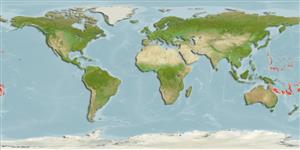Environment: milieu / climate zone / depth range / distribution range
ນິເວດວິທະຍາ
ສັດທະເລ; ນ້ຳຈືດ; ນ້ຳກ່ອຍ ອາໄສຢູ່ໃກ້ໜ້າດິນໃຕ້ພື້ນທ້ອງນ້ຳ; ປາທີ່ມີການເຄື່ອນຍ້າຍຈາກທະເລໄປຫານ້ຳຈືດ ແລະນ້ຳຈືດຫາທະເລ (Ref. 51037); ລະດັບຄວາມເລິກ 1 - 1000 m (Ref. 58302). Tropical; 30°N - 25°S, 140°E - 160°W
Oceania: Mariana Islands south to Vanuatu, New Caledonia and Fiji.
Length at first maturity / ຂະໜາດ / ນ້ຳໜັກ / Age
Maturity: Lm ?, range 7 - ? cm
Max length : 24.5 cm SL ຕົວຜູ້/ບໍ່ມີເພດ; (Ref. 26668); 16.5 cm (female)
Benthic (Ref. 58302). Adults occur from lowland streams and rivers to relatively swift streams at elevations of 1000 m. They often burrow into the substrate with only the eyes showing; feed on filamentous algae, worms, crustaceans, various insects and insects larvae, and suspended food particles; has been long favored as food by the early Hawaiians (Ref. 44091). Larvae develop and metamorphose in the marine zooplankton and as juveniles, about 161 days old, recruit to freshwater streams, where they undergo rapid growth and morphological changes necessary for upstream migration to the adult habitat (Ref. 51037).
Life cycle and mating behavior
ການຈະເລີນເຕັມໄວ | ການສືບພັນ | ການວາງໄຂ່ | ໄຂ່ | ຄວາມດົກຂອງໄຂ່ປາ | ຕົວອ່ອນ
Adults move downstream to their prime breeding just above the estuary; males select crevices and caves formed by rocks on the stream bed where the females will lay their eggs; males guard nests until larvae hatch a day later (Ref. 44091).
Watson, R.E., 1992. A review of the gobiid fish genus Awaous from insular streams of the Pacific Plate. Ichthyol. Explor. Freshwat. 3(2):161-176. (Ref. 26668)
IUCN Red List Status (Ref. 130435)
Threat to humans
Harmless
Human uses
ຂໍ້ມູນຕື່ມອີກ
ເອກະສານອ້າງອີງການລ້ຽງສັດນ້ຳຂໍ້ມູນການລ້ຽງສັດນ້ຳສາຍພັນກຳມະພັນElectrophoresesການຖ່າຍທອດທາງກຳມະພັນຈາກພໍ່ແມ່ຫາລູກພະຍາດການປຸງແຕ່ງNutrientsMass conversion
ເຄື່ອງມື
Special reports
Download XML
ແຫຼ່ງອີນເຕີເນັດ
Estimates based on models
Preferred temperature (Ref.
123201): 9.2 - 23.2, mean 15.6 °C (based on 54 cells).
Phylogenetic diversity index (Ref.
82804): PD
50 = 0.5000 [Uniqueness, from 0.5 = low to 2.0 = high].
Bayesian length-weight: a=0.01122 (0.00570 - 0.02208), b=3.11 (2.95 - 3.27), in cm total length, based on LWR estimates for this species & Genus-body shape (Ref.
93245).
ຊັ້ນເຂດຮ້ອນ (Ref.
69278): 2.2 ±0.1 se; based on diet studies.
ຄວາມຢືດຢຸ່ນ (Ref.
120179): ຂະໜາດກາງ, ປະຊາກອນຕຳ່ສຸດທີ່ໃຊ້ເວລາສອງເທົ່າ 1.4 - 4.4 ປີ (Assuming tm=1-2 and Fec<1000).
Fishing Vulnerability (Ref.
59153): Low vulnerability (11 of 100).
